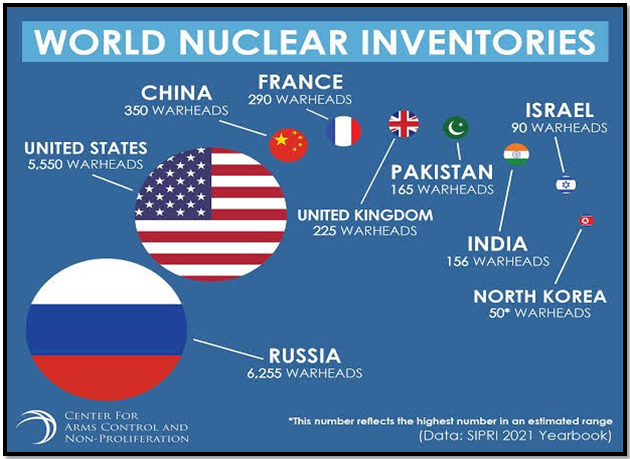THE RISKS OF RUSSIA’S NUCLEAR POSTURING
Syllabus:
GS 2:
- India and its Neighbourhood- Relations.
- Effect of Policies and Politics of Developed and Developing Countries on India’s interests, Indian Diaspora.
Why in the News?
Russia’s recent announcement of nuclear drills near the Ukraine border and plans to station nuclear weapons in Belarus have escalated global tensions, raising concerns about nuclear posturing and the potential for a dangerous shift in the principles of nuclear deterrence.
Source: CACNP
Escalation and Nuclear Drills
- Recent Developments: Russia announced plans to conduct drills simulating the use of tactical nuclear weapons along the Ukraine border, escalating the conflict.
- Stationing Nuclear Weapons: Earlier in March, Russia declared its intention to station nuclear weapons in Belarus, intensifying concerns.
- Citing Western Leaders: Russia’s actions are purportedly in response to statements from French President Emmanuel Macron and British Foreign Secretary David Cameron regarding support for Ukraine.
- Questionable Justifications: The rationale that these statements pose an existential threat to Russia is questionable, as neither France nor the U.K. has made moves that genuinely endanger Russia’s survival.
- Brinkmanship and Coercion: Russia’s nuclear posturing appears to be a strategy of brinkmanship rather than a response to a direct existential threat.
Shift in Nuclear Deterrence Understanding
- Traditional Deterrence: Historically, the principle of mutually assured destruction (MAD) has been the cornerstone of nuclear deterrence, preventing any nuclear use due to the inevitable reciprocal devastation.
- Existential Threat Doctrine: Nuclear options were traditionally reserved for existential threats, ensuring that nuclear weapons remained weapons of last resort.
- Lowering the Threshold: Russia’s consideration of nuclear use in the current conflict signals a dangerous shift, potentially lowering the threshold for nuclear engagement.
- Destabilizing Conventional War: The ongoing war with Ukraine, while destabilizing on a conventional level, does not threaten Russia’s existence, making its nuclear posturing particularly alarming.
- Redrawing Nuclear Red Lines: Russia’s willingness to stretch and redraw established nuclear red lines indicates a worrying shift in the fundamental understanding of nuclear deterrence.
Dangerous Precedents
- Nuclear Coercion: By making explicit nuclear threats at lower levels of conflict, Russia sets a dangerous precedent for nuclear coercion.
- Emboldening Other States: This behaviour could embolden other nuclear-armed states like Iran and North Korea to use nuclear threats as a coercive tactic.
- Undermining Resolve: Smaller nuclear nations might believe that flaunting their nuclear capabilities can force stronger opponents to back down.
- Tactical Nuclear Strikes: Although the odds of a Russian tactical nuclear strike remain low, the signaling undermines the clear distinction between nuclear and conventional warfare.
- Non-Proliferation Efforts: Russia’s actions threaten to derail global non-proliferation and disarmament efforts, as states might pursue nuclear capabilities for deterrence.
Impact on Non-Proliferation
- Security Assurances in Question: The vulnerability of non-nuclear states like Ukraine, which gave up its nuclear arsenal in exchange for security assurances, is highlighted.
- Motivating Proliferation: Russia’s nuclear posture could motivate other states to develop nuclear weapons for self-defense, fearing aggression from nuclear-armed states.
- Iran’s Nuclear Doctrine: Iran’s recent statement about revisiting its nuclear doctrine in response to threats from Israel exemplifies the potential shift towards nuclear armament.
- North Korea’s Reluctance: North Korea may become more resistant to disarmament, seeing the protection nuclear weapons afford against aggression.
- Global Nuclear Instability: Increased proliferation anxieties among smaller states could lead to greater global nuclear instability and undermine disarmament efforts.
| Nuclear Non-Proliferation Treaty (NPT)
About the NPT
Nuclear-Weapon States under the NPT Defined as those that developed and tested nuclear weapons before January 1, 1967. India’s Stand
|
New Nuclear Flashpoints
- Asymmetric Advantages: Russia’s actions illustrate how nuclear weapons provide asymmetric advantages in conventional warfare.
- Lowering the Nuclear Threshold: By raising the risk and lowering the threshold for nuclear use, Russia has altered the global understanding of nuclear deterrence.
- Proliferation Anxieties: The heightened risk of nuclear engagement increases proliferation anxieties, especially in regions with longstanding tensions.
- War Over Deterrence: If the threat of nuclear war becomes more pronounced, it could shift the balance from deterrence to active conflict.
- Nuclear Instability: The current dynamics increase the likelihood of nuclear instability, as nations might prioritize nuclear armament over disarmament and peaceful resolution of conflicts.
Way Forward
- Diplomatic Engagement: Initiate comprehensive diplomatic efforts involving key global powers to de-escalate tensions and prevent further nuclear posturing.
- Strengthening Non-Proliferation Treaties: Reinforce and promote adherence to international non-proliferation treaties like the Treaty on the Non-Proliferation of Nuclear Weapons (NPT) to curb the spread of nuclear weapons.
- Enhanced Sanctions: Implement targeted sanctions against states that threaten nuclear weapon use to deter aggressive nuclear posturing.
- Confidence-Building Measures: Encourage confidence-building measures between Russia and NATO to reduce misunderstandings and the potential for nuclear conflict.
- International Monitoring: Strengthen international monitoring mechanisms to ensure compliance with nuclear disarmament and non-proliferation agreements.
- Dialogue on Nuclear Doctrine: Foster international dialogue to update and reaffirm global norms around nuclear weapons use, emphasizing the catastrophic consequences of nuclear war.
- Support Non-Nuclear Defense: Provide support for non-nuclear defense capabilities to countries at risk, reducing their perceived need for nuclear deterrents.
- Promote Disarmament: Intensify global efforts toward nuclear disarmament, encouraging all nuclear-armed states to take concrete steps towards reducing their nuclear arsenals and enhancing global security.
Conclusion
Russia’s nuclear posturing in the ongoing conflict with Ukraine presents significant risks by lowering the threshold for nuclear weapon use and setting dangerous precedents for other nuclear-armed states. This shift threatens global non-proliferation efforts, increases the risk of nuclear engagement, and undermines the established principles of nuclear deterrence. The international community must address these challenges to maintain global security and stability.
Source:The Hindu
Mains Practice Question:
Discuss the implications of Russia’s nuclear posturing in the ongoing conflict with Ukraine on global nuclear non-proliferation efforts. Evaluate the potential risks and suggest measures that the international community can take to mitigate these challenges.
Associated Article:
https://universalinstitutions.com/russia-claims-capture-of-ukrainian-stronghold-in-luhansk-region/




